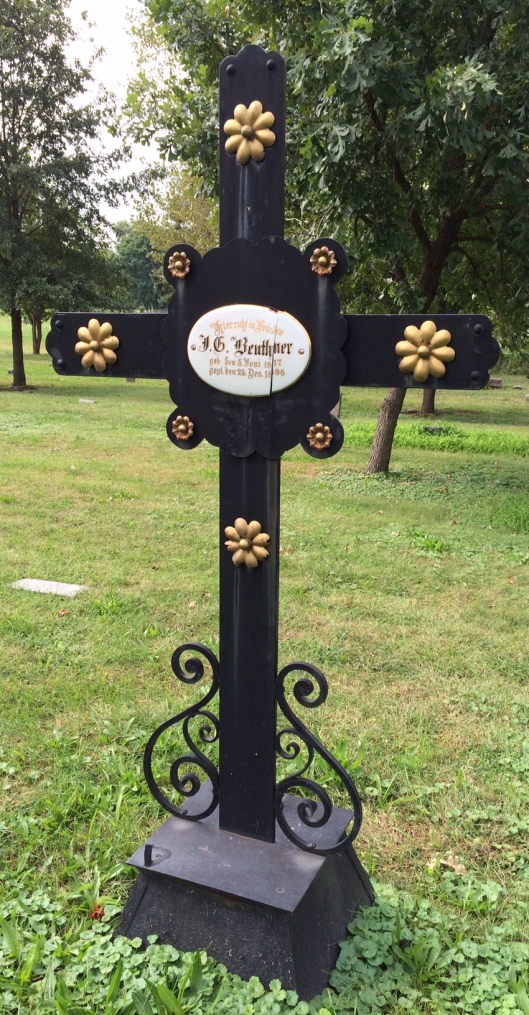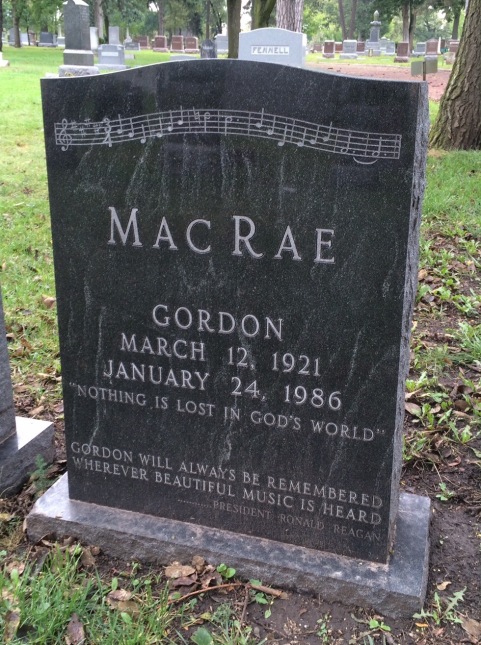When I started this series, I honestly thought I’d be finished in (at most) three parts. As you can see, I was off on that estimation a bit. I do promise that today is indeed the end.
The McDonald family sarcophagus is a bit unusual because a beautiful woman in mourning is leaning over it. I think I took pictures of her at every angle I could. She fascinated me.
A native of Illinois, John McDonald was a banker, financier and real estate investor. He and his wife, Annie, spent a lot of time at their spectacular summer “cottage” at Monmouth Beach, N.J. called “Blow by the Sea.” The McDonalds appeared often in the New York Times, which reported on their summer events and guests.
Soon after her husband died, Annie built a mansion at South 22nd and Washington Streets in Lincoln, which she also called “The Blow.” If you’re curious (as I was) as to why the McDonalds liked this word, it’s thought to be synonymous with the word “respite.” The Lincoln house (which is long since gone) was ornamented with marble statuary. Maybe the person who created those figures sculpted the one on their monument.
I did find a curious story about Annie’s friendship with William Frederick Cody, better known as Buffalo Bill Cody. The famous Wild West showman is said to have attended many of Annie’s parties, which were described as “unusual.”
Not far from the McDonald sarcophagus (in Section 13) is the bust of Albinus Nance, Nebraska’s fifth Governor. A native of Illinois, Nance was born in 1848 and enlisted in the Union Army when he was only 16. Elected to the Nebraska House of Representatives in 1877, Nance became Speaker of the House at the age 29.
 Just a year later, Nance was elected Governor of Nebraska and reelected in 1880. Because of his young age, he is sometimes called the “Boy Governor” of Nebraska. His wife, Sarah White Nance, was only 24 when she became the state’s First Lady. After “retiring” at the age of 35, Nance returned to practicing law and was president of banks in Osceola and Stromsburg, Neb. Nance County was named after him.
Just a year later, Nance was elected Governor of Nebraska and reelected in 1880. Because of his young age, he is sometimes called the “Boy Governor” of Nebraska. His wife, Sarah White Nance, was only 24 when she became the state’s First Lady. After “retiring” at the age of 35, Nance returned to practicing law and was president of banks in Osceola and Stromsburg, Neb. Nance County was named after him.

The Nance bust was sculpted by noted artist Gilbert Riswold, who studied with a more famous sculptor, Lorado Taft.
An interesting bit of trivia is that Nance’s bust was signed by Gilbert Riswold, who studied in Chicago with none other than Lorado Taft (best known for his sculpture “Eternal Silence” in Chicago’s Graceland Cemetery that I featured last year).
A much smaller but no less impactful monument is at the grave of little Irmgard Christine Winter, who died from diphtheria before she reached the age of 5.
Christine’s parents, Phillip and Alta Winter, paid homage to their little girl (“Our Morning Glory”) with the largest photographic portrait in Wyuka. Alta, Pauline, Philip and Wilhemine Winter are also interred in the family plot.
A visually unique modern grave marker is situated in Section 1. A beloved second-grade teacher and wife of a Lincoln Public Schools board member, Barbara Evans died of a cerebral hemorrhage at the age of 54 in 2000. The family chose to commemorate her life with a round granite table and four granite stools, a picnic table which all are invited to share.

Beloved teacher Barbara Evans’ family had this table and stools created so friends visiting her grave could sit and reflect.
The F. Gottlieb Beuthner iron cross is easily noticed because it is the only one of its kind at Wyuka. However, they’re fairly common in Midwestern cemeteries where many German immigrants are buried.
 I like to end my cemetery series posts on an upbeat note but in the case of Wyuka, I cannot.
I like to end my cemetery series posts on an upbeat note but in the case of Wyuka, I cannot.
Wyuka’s guidebook is quite exhaustive about those buried there. But the most infamous person is not mentioned at all. I think it’s an unspoken wish to not give someone who caused so much pain any more attention than he already gets.
Charles Raymond “Charlie” Starkweather’s name sends chills down the spine of many a Nebraskan and for good reason. Along with his 14-year-old girlfriend Caril Ann Fugate, Starkweather killed 11 people in Nebraska and Wyoming. All but one were killed between January 21 and January 29, 1958.

Charles “Charlie” Starkweather, with his teenage girlfriend Caril Ann Fugate in tow, murdered 11 people in two states.
Starkweather grew up in Lincoln, the son of Guy and Helen Starkweather. After dropping out of Lincoln High School, Starkweather bounced from job to job before meeting Caril Ann Fugate. She was not with him when he committed his first murder, shooting Lincoln service station attendant Robert Colvert on Nov. 30, 1957.
The other murders began on January 21, 1958 when Starkweather went to see Caril Ann at her home (she was not there) and her parents wouldn’t let him in. He shot them both and soon after killed Caril Ann’s two-year-old step-sister, Betty Jean. When Caril Ann got home, she reportedly helped him hide the bodies. After a few days, they left home.
Over the next several days, the pair would kill Starkweather family friend August Meyer; young couple Robert Jensen and Carole King; industrialist C. Lauer Ward, his wife, Clara, and their maid, Lilyan Fencl; and traveling salesman Merle Collison.
Fugate and Starkweather were finally arrested after a high-speed car chase with the police. Fugate swore that Starkweather held her hostage by threatening to kill her family, claiming she didn’t know they were already dead. The presiding judge at her trial (nor the jury) didn’t buy her story.

Caril Ann Fugate with Chalres Starkweather in the days before the killing spree. She has always insisted she had no part in the murders and that he had kidnapped her.
Starkweather was found guilty and received the death penalty for the murder of Robert Jensen, the only murder for which he was tried. He was executed in the electric chair at the Nebraska State Penitentiary in Lincoln on June 25, 1959.
An anonymous donor paid for Starkweather’s first marker in 1970, which was vandalized. Wyuka’s president, Michael Williams, told me that actor Martin Sheen (who portrayed Starkweather in the 1973 film Badlands) purchased a new marker for Starkweather. That’s the one pictured below.
 Fugate received a life sentence on November 21, 1958. She was paroled in June 1976 after serving 17 years and settled in Lansing, Mich., working as a janitor at a local hospital. She married Frederick Clair in 2007 and, apart from a radio interview in 1996, has refused to speak of the murder spree.
Fugate received a life sentence on November 21, 1958. She was paroled in June 1976 after serving 17 years and settled in Lansing, Mich., working as a janitor at a local hospital. She married Frederick Clair in 2007 and, apart from a radio interview in 1996, has refused to speak of the murder spree.
After her marriage, Fugate changed her name to Caril Ann Clair and was living in Stryker, Ohio when she was seriously injured in a car crash on August 5, 2013. Her husband was killed in the crash.
Five of Starkweather’s victims are buried at Wyuka. Fugate’s step-father, Marion Bartlett, her mother, Velda Bartlett, and her step-sister, Betty Jean Bartlett, are buried only about a hundred feet from Starkweather. I was unaware of this when we were at Wyuka so I didn’t get pictures of their graves.
I did locate the graves of the two other victims, C. Lauer Ward and his wife, Clara. The killers broke into their home and found Clara, along with the family maid, Lilyan Fencl. They were stabbed multiple times. When Mr. Ward came home, he was attacked and killed as well. Their son, Mikey, was not at home at the time.
Lilyan Fencl is buried in Sunrise Cemetery in Wahoo, Neb., which I visited later that day on our way back to Omaha. I will feature her story when I write about that cemetery next week.
As we prepared to leave the cemetery, I realized how fast the time had flown. But Wyuka is the kind of place you can spend hours in rambling from grave to grave, there are so many that catch the eye.
At the same time, we had little time but lots more to see. So we got in the car to find a place to eat a very late lunch before heading to Wahoo.
































































